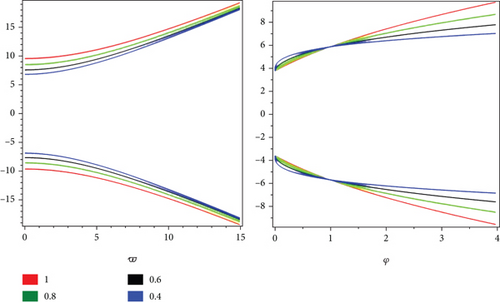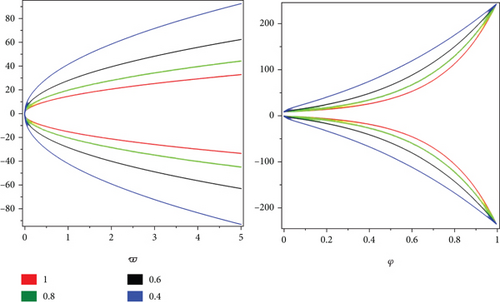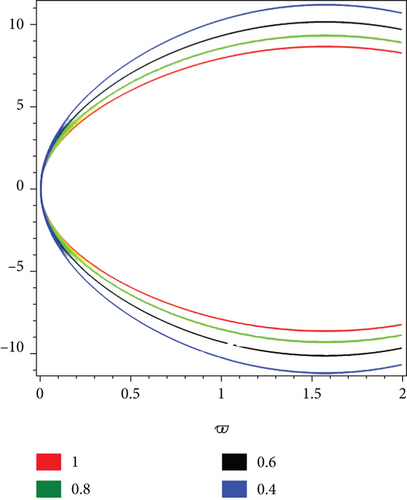Novel Evaluation of Fuzzy Fractional Biological Population Model
Abstract
This article discusses an iterative transformation method via fuzziness that mixtures the Laplace transform with the iterative iterative method. Using Caputo derivative operator, the proposed technique demonstrates the inherent reliability of fractional fuzzy biological population equations with initial fuzzy conditions. The obtained results to the fuzzy fractional biological equations are more general and apply to a broad variety of problems. A parametric description of the solutions is obtained by translating the fuzzy fractional differential equation into an equivalent system of corresponding fractional differential equations. The proposed method is numerically tested against crisp solutions and those produced by other methods, demonstrating that it is a convenient and remarkably accurate way to solve a tool for solving a wide variety of physics and engineering problems.
1. Introduction
Fuzzy set theory is a very useful technique for simulating uncertain problems. As a result, fuzzy notions have been used to represent a wide variety of natural events. The fractional fuzzy differential equation is a model that is extensively used in a range of scientific domains, including the evaluation of weapon systems, electro hydraulics, population modeling, and civil engineering problems. In fuzzy calculus, therefore, the concept of the fractional derivative is essential. Consequently, fuzzy fractional differential equations have attracted a great deal of interest in the domains of science and mathematics [1–3]. The first is an Agarwal et al. [4] work on fuzzy fractional differential equations. In order to analyze fractional fuzzy differential equations, under the Hukuhara notion, they developed the Riemann-Liouville idea. The reality is that we still reside in a world of confusion and ambiguity. Many individuals are susceptible to questioning everything around them and pondering why this is for them or others. Because their reports are poor or incorrect and lack clarity [5], assume we are in a situation where there is a great deal of incorrect information and uncertainty. Many of our reasonable questions cannot be answered because they are found on inaccurate facts. This mind set, characterized by an acceptance of ambiguity, is crucial for scientists [3, 6–8].
Recent emphasis has been placed on fractional calculus as a helpful tool for getting actual answers to science and math problem including as communication systems, aerodynamic and process control, and bio mathematical problems [9, 10]. In addition, several scholars have examined fractional differential equations under fuzzy conditions and solved them utilizing a different technique [11–13]. Hoa used [14] to investigate fractional fuzzy differential equations with Caputo gH-differentiability. Concurrently, Agarwal et al. undertook research on the identical topic in [15] to illustrate its applicability to optimal control problems. Long et al. [16] demonstrated the solvability of fuzzy fractional differential equations, while Salahshour et al. [17] implemented Laplace fuzzy transform to investigate the problems and so on [18–20].
In this case, the fractional order is taken into account in the Caputo sense. Furthermore, Gurney and Nisbet [23] used (v) as a special example in order to simulate and assess the animal population. The preparations are generally performed by young animals who want to create their own breeding area after reaching maturity and migrating adult animals who have strayed from their natal territory who are threatened by mature intruders. It is far more likely that they will be directed toward the neighbouring unoccupied land in any of these two scenarios. The size of the population density gradient between these two possibilities resolves the probability distribution on the mesh side [24–26].
For p(v), the following are illustrations of governing equations (i) p(v) = cv, c = constant, Malthusian law [21]. (ii) p(v) = c1v − c2v2, c1, c2 = positive constant, Verhulst law [22]. (iii) p(v) = cvγ, (c > 0, 0 < γ < 1), porous media [27, 28]
Several academics have recently developed more precise and effective strategies for finding and analyzing solutions to nonlinear and complicated issues. George Adomian, an American mathematician and aeronautical engineer, invented the Adomian decomposition technique (ADM) [29] in response to this. ADM has been successfully used to investigate the behaviour of nonlinear systems without the need of linearization or perturbation. ADM, on the other hand, needs a lot of time and computer memory for computational effort. Rawashdeh and Al-Jammal created and nurtured the natural decomposition method [30, 31], which is a hybrid of natural transform and Adomian decomposition method, to meet these needs. FNDM does not need pertubation, linearization, or discretization because it is an enhanced version of ADM. Many mathematicians and physicists have recently used FNDM to comprehend physical behaviour in a variety of complicated situations due to its dependability and efficacy [32, 33]. The considered technique is unique in that it uses a simple method to assess the result and is based on Adomian polynomials, which allows for quick convergence of the found solution for the nonlinear section of the issue. With the arbitrary external parameter, these polynomials generalise to a Maclaurin series. Many writers have solved the given biological population model using various numerical and analytical approaches in order to examine the behaviour and demonstrate the effectiveness of the algorithms [34–36].
2. Basic Definitions
Definition 1. Consider a fuzzy continuous function on [0, ω] ∈ R; fuzzy fractional Riemann-Liouvilli integral is defined as
Moreover, if , where CF[0, ω] represents the universes of fuzzy continue function and LF[0, ω] represents the continuous fuzzy space function. If the functions are Lebesgue integrable, then the fuzzy fractional integral is defined as
Definition 2. For a term , such that , and φ0 ∈ (0, ω), then the fuzzy Caputo fractional derivative is define as
Definition 3. The fuzzy Laplace transform for f(℘), where f(℘) is the fuzzy value function, is given as
Definition 4. In fuzzy convolution function, a Laplace fuzzy transform is define as
Definition 5. The “Function Mittag-Leffler” Eρ(p) is defined as
Definition 6. Let be a count with the appropriated fuzzy quality
- (i)
κ is an upper semicontinue numbers
- (ii)
κ{μ(χ1) + μ(χ2)} ≥ min{κ(χ1), κ(χ2)}
- (iii)
∃χ0 ∈ R such that κ(χ0) = 1, i.e., v is normal
- (iv)
is compact
The fuzzy set number is shown by the symbol E.
Definition 7. The preceding number can be expressed in parametric representation as , so that σ ∈ [0, 1] in addition to the values
- (i)
from the left is a continue, and bound functions are growing across the range [0, 1]
- (ii)
from right is continue, and bound functions decrease over [0, 1]
- (iii)
.
Theorem 8. Let ℏ′(ψ) be a fuzzy integrable value function, and ℏ(ψ) is the primitives of ℏ′(ψ) on [0, ∞). Then, where ℏ is (i)-differentiable or where ℏ is (ii)-differentiable [37].
Proof. For arbitrary fixed σ ∈ [0, 1], we have
Since ℏ is (i)-differentiable, it follows that
Now, we assume that ℏ is the (ii)-differentiable; for arbitrary fixed σ ∈ [0, 1], we have
Theorem 9. Let ℏ(ψ), g(ψ) be continuous fuzzy-valued functions suppose that c1, c2 are constant, then [37].
Proof.
Hence,
Remark 10. Let ℏ(ψ) be continuous fuzzy-value function on [0, ∞) and λ ≥ 0; then,
Proof. Fuzzy Laplace transform λ⊙ℏ(ψ) is denoted as (p > 0 and integer), and also, we have
Remark 11. Let ℏ(ψ) be continuous fuzzy-value function and g(ψ) ≥ 0. Suppose that (ℏ(ψ)⊙g(ψ))⊙e−pψ is improper fuzzy Rimann-integrable on [0, ∞), then
Theorem 12. Let ℏ is continuous fuzzy-value function and , then [37]
Proof.
3. Road Map of the Current Method
3.1. Numerical Results
Example 1. Consider the fractional fuzzy biological population model
We can write the series form solution
In general, we can write as follows:
The exact result is
We have given simulation of problem 1 at different noninteger order (0 < ρ ≤ 1) for lower and upper portions of fuzzy solutions given in Figure 1 in two-dimensional form, respectively. The two similar color legends show the lower and upper branches of fuzzy solutions, respectively.
Example 2. Consider the fractional fuzzy biological population model
We can write the series form solution
In general, we can write as follows:
The exact result is

We have given simulation of problem 2 at different noninteger order (0 < ρ ≤ 1) for lower and upper portions of fuzzy solutions given in Figure 2 in two-dimensional form, respectively. The two similar color legends show the lower and upper branches of fuzzy solutions, respectively.
Example 3. Consider the fractional fuzzy biological population model
We can write the series form solution
In general, we can write as follows:
The exact result is

We have given simulation of problem 3 at different noninteger order (0 < ϱ ≤ 1) for lower and upper portions of fuzzy solutions given in Figure 3 in two-dimensional form, respectively. The two similar color legends show the lower and upper branches of fuzzy solutions, respectively.

4. Conclusion
In this paper, a concept of fuzzy Caputo fractional derivative was employed and introduced to analysis solutions of fuzzy biological population equations. An important example validated the conclusion reached. Additionally, we supplied graphs of the numerical solution in a variety of fractional order. Moreover, a technique was suggested to analysis results of fuzzy biological population equations in sense of Caputo operator. As a result, some concrete applications are shown to validate the theoretical framework based on the fuzzy Caputo calculus. Using this notion, we confirm that the proposed study can be used effectively as an extended planner in dealing with many sorts of uncertain situations in engineering and applied mathematics. To summarize, obtaining analytical solutions for many forms of fuzzy fractional differential equations is difficult. As a result, future studies must focus on analyzing and solving fractional fuzzy integro differential equations and fractional fuzzy dynamical systems based on the different derivative of fractional order ρ.
Conflicts of Interest
The authors declare that there are no conflicts of interest regarding the publication of this article.
Open Research
Data Availability
The numerical data used to support the findings of this study are included within the article.




